Hope everyone had a great Fourth of July holiday! I personally spent a lot of time at the beach, and got myself a nice sunburn to match (likely ironic justice for all my bragging on Thursday). More of summer is yet to come, including MLB’s All-Star game next week. As a dedicated National League fan, this game has given me more heartbreak than I care to remember, especially when you consider recent years (Trevor’s blown save, last year’s extra innings epic). And with home field advantage at the World Series on the line, any fan cheering for a contender has a vested interest in the outcome.
Now, I know that the All-Star game can be a bit polarizing. For starters, many fans dislike the home field advantage, “This time it counts” rule. And given the elevated seriousness of the game, the managers still run it in a way where they try to get everyone in the game. So, it’s got a bit of an exhibition feel, yet there’s something important on the line.
To be honest, I personally don’t have a huge issue with how it’s run. I like that there’s at least something to motivate players to want to win, and though it directly contradicts trying to earn that home field advantage prize, I don’t have a huge issue with rotating in players. If I could make one major change, I’d expand the rosters by a few players, to ensure there’s always enough pitching to get through an extra inning game (this was an inning away from becoming a major problem last year). And this did happen a bit for 2009, as the rosters have expanded from 32 to 33.
In any event, the rosters are set, and I’m hoping the National League can finally take one next week. I’ll be going over the starting rosters by position, which isn’t the most scientific approach, but should be a fun exercise and a nice way to see where each team’s strengths and weaknesses are.
As a note here, I’ll be showing each player’s stats for the season thus far, and their stats from last year as well. We’ve seen a lot of players have a really hot first half only to fall off, and lots of votes are based somewhat on what the player has done in past seasons. So this should give us a more complete picture of how these players stack up.
Catcher
Yadier Molina (National League)
2009 AVG/OBP/SLG to date: .281/.347/.381
2008 Stats: .304/.349/.392
Joe Mauer (American League)
2009 AVG/OBP/SLG to date: .389/.465/.648
2008 Stats: .328/.413/.451
You’ve got to give it to St. Louis fans: they sure are dedicated. While Yadier Molina is a fine catcher that almost any team would be thrilled to have, I’d say this spot really belongs to Brian McCann. His .304/.388/.495 line in 2009 is superior to Molina’s in every way, and McCann is good for 20ish home runs a year. Yadier has yet to hit ten in a season. But hey, the game is being played in St. Louis, so here’s giving one to the hometown fans. And if it closes the gap a bit, once you put the bats away, Molina is better behind the dish than McCann.
Where the American League is concerned, there’s absolutely no question as to who earns this spot. As of today, Joe Mauer is leading his league in Average, OBP and Slugging. Every single stat. He’s managed to find quite the power stroke this year, already hitting 14 home runs (keep in mind he was out for a bit at the start of the year with an injury). He also led the AL in batting average in 2006 and 2008, so this is not a fluke. Having these kinds of numbers from even a first baseman or outfielder would be good enough, but getting them from a guy who squats for nine innings while calling a game is even better.
Advantage: American League
First Base
Albert Pujols (National League)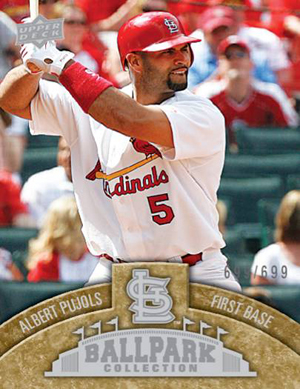
2009 AVG/OBP/SLG to date: .336/.460/.739
2008 Stats: .357/.462/.653
Mark Teixeira (American League)
2009 AVG/OBP/SLG to date: .278/.388/.555
2008 Stats: .308/.410/.552
Well, here’s one where the St. Louis fans will be happy with the choice, along with every National League fan.
Pure and simple, Albert Pujols is a monster. He’s easily the best hitter of this generation, and considering his worst power year was 32 home runs (he’s hit this or more each season, including his rookie year at age 21 in 2001), there’s no telling what his career will look like when all is said and done. Oh, he’s very good defensively too (with a Gold Glove to go along with his two MVPs).
Mark Teixeria isn’t exactly chopped liver himself. He has a lifetime OPS of .921, is a switch hitter, and has two Gold Gloves in his pocket. If we’re going purely by this year’s stats, Youkilis probably should have gotten the start with his .301/.423/.569 line (all stats better than Teixeira), but there really isn’t a massive difference between the two, especially when you consider that Tex always slumps in April.
Advantage: National League
Second Base
Chase Utley (National League)
2009 AVG/OBP/SLG to date: .301/.426/.559
2008 Stats: .292/.380/.535
Dustin Pedroia (American League)
2009 AVG/OBP/SLG to date: .290/.368/.393
2008 Stats: .326/.376/.493
Second base has definitely had a renaissance over the last few years: Chase Utley and last year’s AL MVP are leading the charge. With the Rookie of the Year and MVP credentials, Pedroia seems to get more attention (and playing in a baseball obsessed city helps). Both players own a World Series ring this early in their careers, and Utley has a bit more experience.
If we’re going to compare, Utley certainly slugs more and his OBP is better this season, so I’ve got to give him the nod. Though he doesn’t have a MVP under his belt (yet), he’ll hit more home runs, while still hitting for average, taking plenty of walks, and even stealing bases when the opportunity presents itself.
Advantage: National League
Shortstop
Hanley Ramirez (National League)
2009 AVG/OBP/SLG to date: .346/.409/.574
2008 Stats: .301/.400/.540
Derek Jeter (American League)
2009 AVG/OBP/SLG to date: .316/.390/.460
2008 Stats: .300/.363/.408
This one is pretty easy: Hanley Ramirez is one of, if not the best young talent in baseball today. Derek Jeter has four rings and will probably be a Hall of Famer when all is said and done. At this stage in his career, he mostly hits for average, takes walks, and scatters in a few home runs and doubles for good measure. Hanley does all that, takes more walks, hits home runs, and steals a ton of bases too.
Advantage: National League
Third Base
![]() David Wright (National League)
David Wright (National League)
2009 AVG/OBP/SLG to date: .326/.414/.470
2008 Stats: .302 /.390/.534
Evan Longoria (American League)
2009 AVG/OBP/SLG to date: .290/.369/.545
2008 Stats: .272/.343/.531
If you look at Pedroia and Utley above, then look at these two guys, you’ve got four remarkably talented infielders who came up, and with a few minor hiccups here and there, have become perennial All-Star talents before hitting their mid-20s. This right here is what baseball in 2009 is all about.
As one Mets blogger put it recently, “David Wright picked the wrong year to go for a batting title.” CitiField, the Mets new home, thus far is playing like a home run suppressor. So, Wright has apparently adjusted his approach, looking to hit into the gaps and is no longer swinging for the fences: and to be fair, that’s always more or less been what Wright does. This is his fifth full season in the league, but the most home runs he’s ever hit was 33.
On the American League side of things, Longoria is a stud, plain and simple. This is only his second year in the league, so you can go ahead and stare at the two stat lines below his name, as they encompass his accomplishments to this point: he’s only 23. Oh, and he’s one of the best defensive third basemen in the game today.
Thinking about this one, I think you need to call it even. Yes, Wright’s power has been significantly diminished this year, but he’s still right on pace to hit 40 doubles yet again. His approach is fine, he’s more or less adjusting to the stadium: if he were hitting in Philadelphia or the Bronx, he might very well have 10-15 home runs by now.
Longoria’s defense is better, he’s younger, and will probably have more power. But there’s a big difference between a .290 and a .326 average, or a .369 OBP against a .414. The difference in home runs makes this even enough, and Wright had a better 2008. So I’ve got to call this one a push.
Advantage: Even
Outfield
Raul Ibanez (National League)
2009 AVG/OBP/SLG to date: .312/.371/.656
2008 Stats: .293/.358/.479
Ryan Braun (National League)
2009 AVG/OBP/SLG to date: .326/.409/.557
2008 Stats: .285/.335/.553
Brad Hawpe (National League)
2009 AVG/OBP/SLG to date: .327/.401/.589
2008 Stats: .283/.381/.498
Probable Reserve: Justin Upton (National League)
2009 AVG/OBP/SLG to date: .300/.378/.540
2008 Stats: .250/.353/.463
Ichiro Suzuki (American League)
2009 AVG/OBP/SLG to date: .362/.396/.486
2008 Stats: .310/.361/.386
Jason Bay (American League)
2009 AVG/OBP/SLG to date: .260/.371/.527
2008 Stats: .286/.373/.522
Josh Hamilton (American League)
2009 AVG/OBP/SLG to date: .240/.290/.456
2008 Stats: .304/.371/.530
Probable Reserve: Torii Hunter (American League)
2009 AVG/OBP/SLG to date: .304/.381/.565
2008 Stats: .278/.344/.466
There’s a bit of cloudiness around the outfield due to injuries and positional eligibility, and here’s how I see it shaking out.
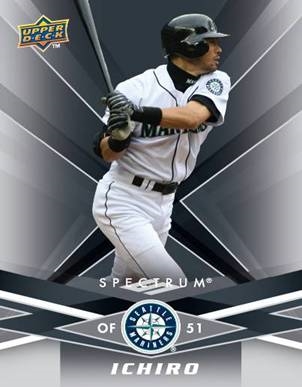 National League: Carlos Beltran’s injury moved Brad Hawpe into the starting lineup, giving the National League a fairly poor defensive alignment with Braun, Hawpe and Ibanez. Aside from Braun and Ibanez not having the best reputations with the glove, Hawpe isn’t a guy you want to rely on to patrol center field. Compounding the matter is Ibanez coming back from a groin injury, so it remains to be seen if he’ll be ready to play by next week, and in that case, what will his timing be like? But given that Ibanez has been a consistent player who has never even been to an All-Star game, you have to feel he’ll want to be there, and at least get an at bat.
National League: Carlos Beltran’s injury moved Brad Hawpe into the starting lineup, giving the National League a fairly poor defensive alignment with Braun, Hawpe and Ibanez. Aside from Braun and Ibanez not having the best reputations with the glove, Hawpe isn’t a guy you want to rely on to patrol center field. Compounding the matter is Ibanez coming back from a groin injury, so it remains to be seen if he’ll be ready to play by next week, and in that case, what will his timing be like? But given that Ibanez has been a consistent player who has never even been to an All-Star game, you have to feel he’ll want to be there, and at least get an at bat.
So, all things being equal, I expect Ibanez to get one at bat, if he plays at all. This means Justin Upton comes in as the de facto center fielder, allowing Hawpe to play right, and Braun to play left (where both are comfortable).
American League: In a similar situation to Ibanez, Josh Hamilton is just returning from an injury as well. Though of course, the one major difference here is that Hamilton is thus far having a very poor year, whereas Ibanez is having a career year. Again, the fans voted him in, so if he’s healthy enough to play I expect Hamilton will get an at bat, maybe play the outfield for an inning or two, then make way for Torii Hunter (again, allowing Bay and Ichiro to play their natural corner positions).
Assuming things play out this way, we’re looking at Braun, Upton and Hawpe on the National League side, and Bay, Hunter and Ichiro for the American League. I’d give Braun the nod over Bay, and actually give Upton the nod over Hunter in center: while Hunter has been very good for a long time, he’s more or less having one of the best seasons of his career at the moment, and I assume we’ll see some regression there in the second half. Meanwhile, Upton has been one of the most promising young players in the game since being drafted, and it looks like he’s living up to his great potential, as opposed to simply having a good first half.
For right field I’ve got to give the nod to Ichiro over Hawpe. Hawpe is a fine player whose stats are probably inflated a bit thanks to Coors, but Ichiro is a Hall of Famer based on his MLB career alone.
Advantage: National League, 2-to-1
Pitching
As is the case with all baseball games, pitching should be the most important factor of the All-Star game. However, it’s a bit of an odd creature here: if you’re the best pitcher in your league, and you just threw on the last day before the break, there’s no way you’re going out there to throw at the All-Star game. So, if say Tim Lincecum pitches for the Giants on July 12th, he’s not making an appearance for the National League on July 14th. And even the best starters on each side are only going to go a few innings each.
Therefore, all we can do really, is look at the depth on the rosters, and figure out who has the best options available:
National League
Heath Bell, SD
Chad Billingsley, LAD
Jonathan Broxton, LAD
Matt Cain, SF
Francisco Cordero, CIN
Ryan Franklin, STL
Dan Haren, ARI
Josh Johnson, FLA
Ted Lilly, CHC
Tim Lincecum, SF
Jason Marquis, COL
Francisco Rodriguez, NYM
Johan Santana, NYM
American League
Andrew Bailey, OAK
Josh Beckett, BOS
Mark Buehrle, CWS
Brian Fuentes, LAA
Zack Greinke, KC
Roy Halladay, TOR
Felix Hernandez, SEA
Edwin Jackson, DET
Joe Nathan, MIN
Jonathan Papelbon, BOS
Mariano Rivera, NYY
Justin Verlander, DET
Tim Wakefield, BOS
While the National League has won the majority of the position battles above, it looks like the AL has the advantage in pitching, both with starters and relievers. Again, so much of this will be based on who is available to begin with, but I think the AL’s front three of Greinke, Halladay and Hernandez trumps the NL’s Lincecum, Haren and Santana. If I had to guess, I think we’ll see Greinke against Haren to start this game: both pitchers are having tremendous starts to the season, and are on non-contenders who don’t need to save the bullets of their aces (and quite frankly, wouldn’t mind the positive exposure for their franchises).
The bullpen is the usual song and dance for the American League: Nathan, Papelbon and Rivera, and I dare you to match that. Sorry, but K-Rod, Cordero, Bell and Franklin don’t stack up: great closers in their own right, no doubt, but the American League’s big three are all potential Hall of Famers.
Advantage: American League
Now obviously, the game won’t quite look as straightforward as this. I expect most of the players on the bench to get into the game at some point, so the starting rosters will rotate. The one disadvantage the National League has there is glut of first basemen with Ryan Howard, Prince Fielder and Adrian Gonzalez on the bench. Because we’re playing in St. Louis, the game is under National League rules, so there’s no DH to rotate these guys. And given that Pujols is playing in his home stadium, I expect he’ll play for most, if not all of the game. This means the National League will have some pretty nice pinch hitters to go to, though they’ll be down some utility off the bench.
Key to the Game: If the National League is going to break their losing streak, Haren or Lincecum (potentially both) need to pitch to their abilities while the position players score some runs. Getting an early lead and keeping it is key: if the American League can get to their premium closers with the lead intact, it’ll be hard to get past them. And if Greinke gets the start, and brings his A-game, it could be pretty difficult to make that happen.





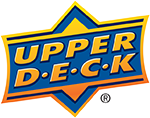


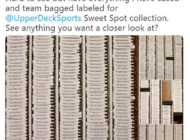
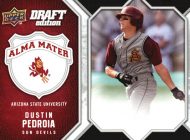
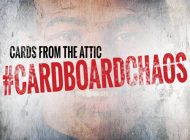
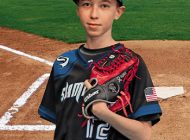

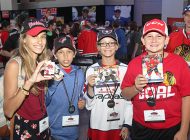
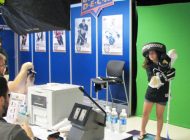
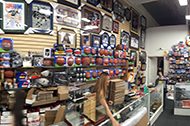
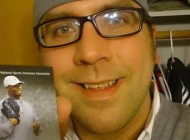
3 Comments
[…] a fun time to be a baseball fan right now: next week is the All-Star game, and soon after we’ll hit the trade deadline. In case you missed it, click here to see my […]
There will be a ton of fun All-Star activities on the arch grounds this weekend in addition to the game. Cardinals Hall of Fame, The Perfectos: a vintage-style baseball game and the charity concert featuring Sheryl Crow, just to name a few!
[…] I got a little enthusiastic last week, posting my analysis of this year’s All-Star game before…. What can I say, it’s been many years since my National League won, and I’m thinking we […]